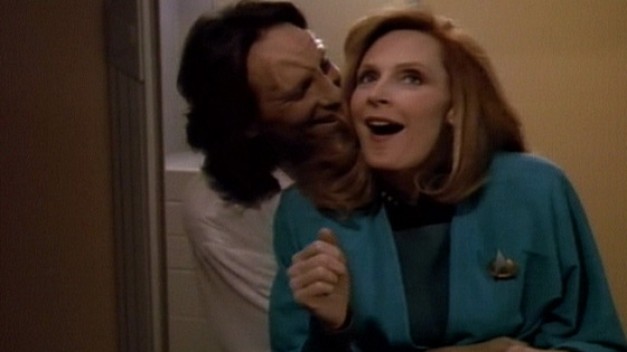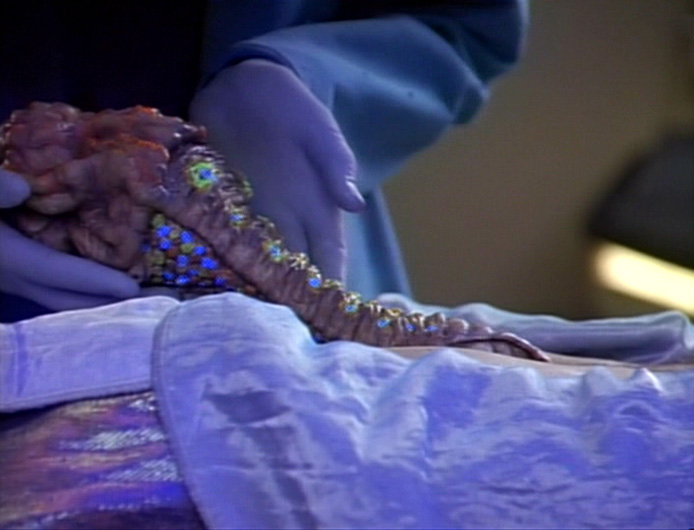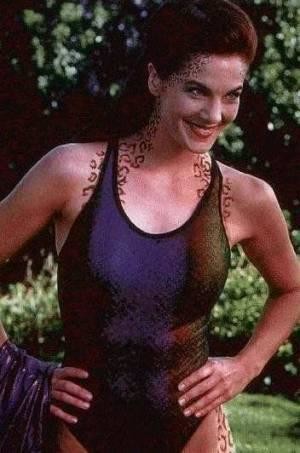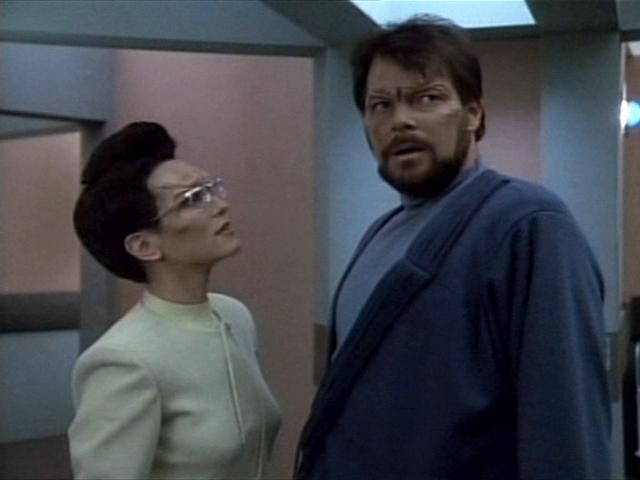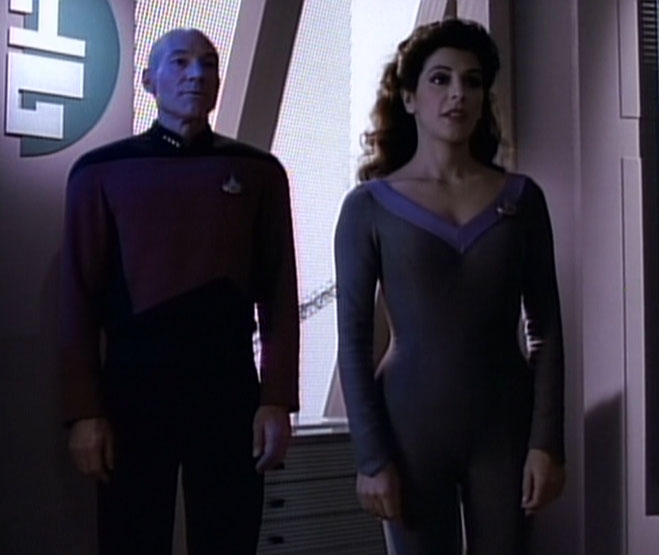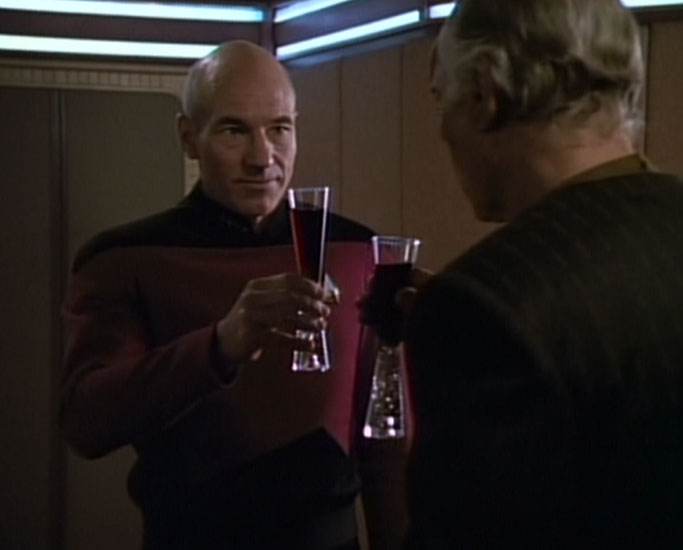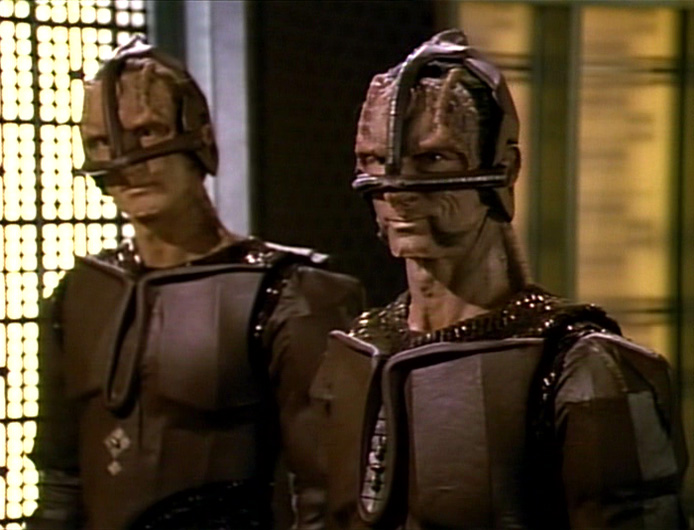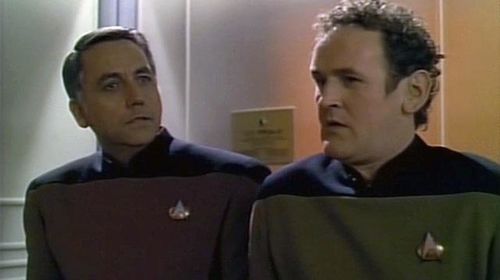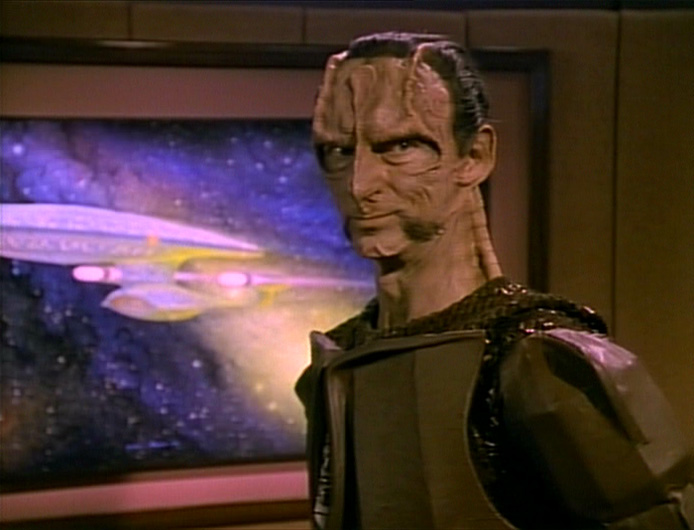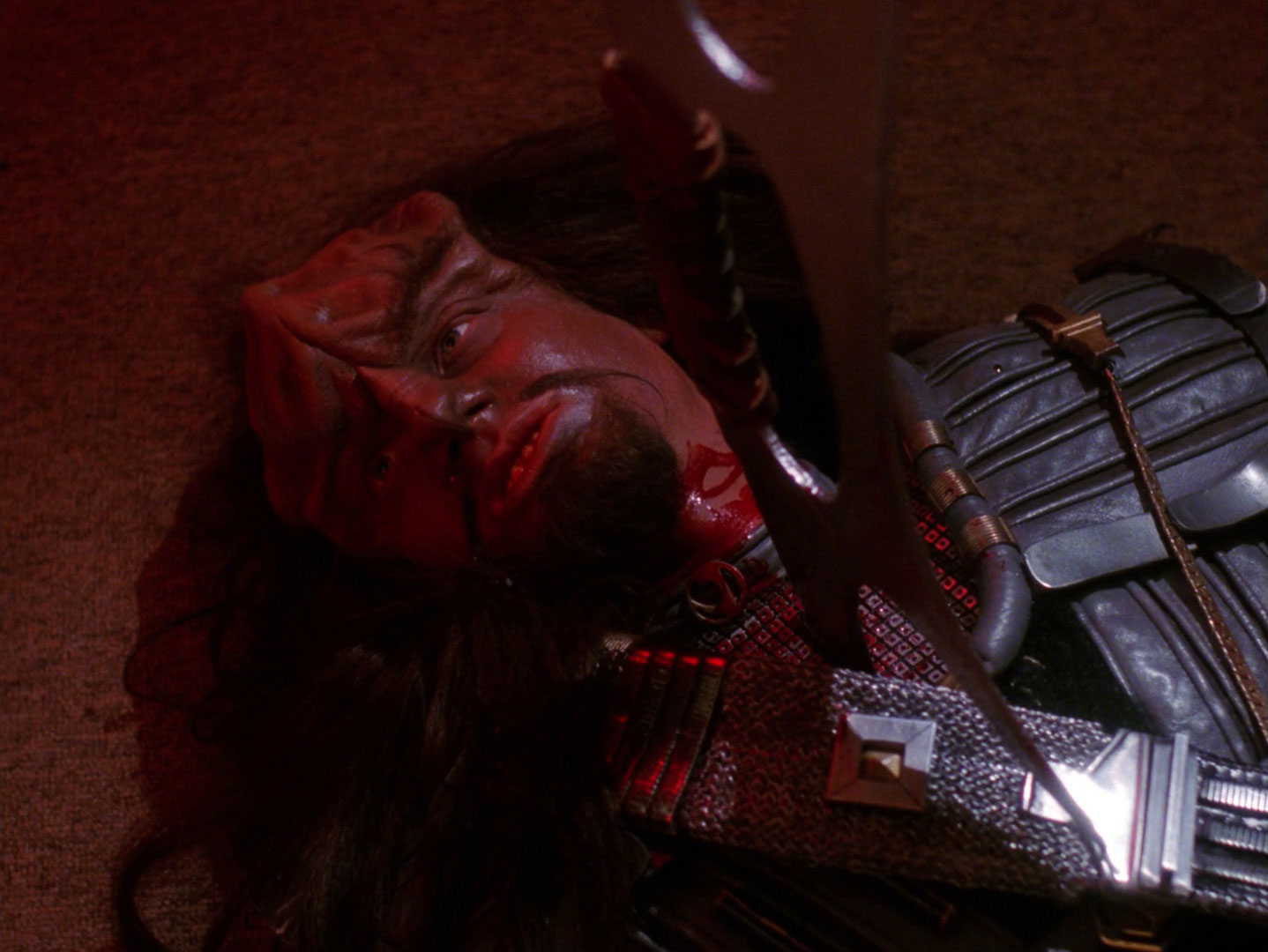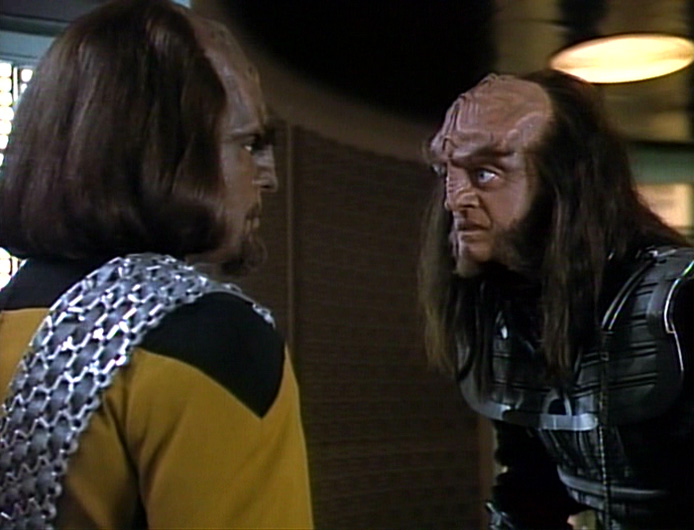
Part I: The Enterprise heads to the Klingon homeworld so Picard can finish his duties as arbiter of succession (see “Reunion”). New Klingon leader Gowron (Robert O’Reilly) pops up and tells Picard he needs help to avert a civil war (actually a “KLINGON CIVIL WAR”, as Gowron says, somewhat annoyingly). Turns out the family of Duras — who had been in the running for the top spot before Worf killed him and went medieval on his ass — is staging some sort of a power play. Later, at Gowron’s induction, Duras’s sisters, Lursa (Barbara March) and B’Etor (Gwynyth Walsh) show up and bring with them Duras’s illegitimate son, Toral (JD Cullum), whom they say should rule the empire (females can’t serve on the council, apparently). Meanwhile, Worf convinces his brother Kurn (Tony Todd) to support Gowron in hopes that doing so will force Gowron to return their family honor (see “Sins of the Father”). Picard rules against the Duras claim and civil war erupts. The Federation can’t intervene in an internal matter, so Worf resigns from Starfleet to fight for Gowron — who overturns the decision that made Worf a pariah now that Kurn and his allies have joined his cause. Meanwhile, we learn that the Romulans — including a blond commander who looks a lot like the mom from “Pet Semetary” — are helping the Duras.
Part II: With the war raging and Gowron losing, Picard gets Starfleet to approve his plan to determine whether the Romulans are helping the Duras family. He takes a small fleet to the Romulan border equipped with Geordi’s newest innovation that will determine if cloaked ships are in the area. That prompts Romulan Commander Sela (Denise Crosby) to appear. She demands Picard remove the blockade and tells him that she is Tasha Yar’s half-Romulan daughter, and that Tasha was on the Enterprise-C when it was captured 23 years earlier. Guinan (who has an inkling of what happened in “Yesterday’s Enterprise” because of her Guinan-ness) confirms the claim. Sela’s people find a way to disrupt Picard’s sensor net, but Data saves the day by finding another way to detect the Romulans, who turn back once they’re discovered. Without Romulan assistance, the Duras forces fall to Gowron, and Kurn rescues Worf (who had been captured). Lursa and B’Etor escape, but Gowron gives Worf the chance to kill Toral. He declines, and with the war over, resumes duty on the Enterprise.
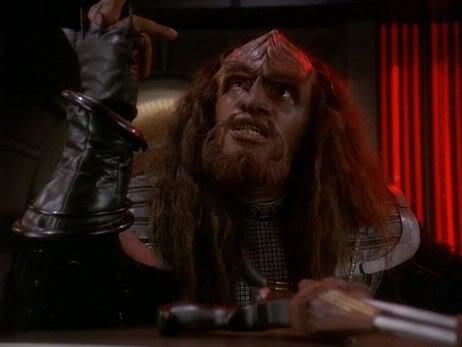
Why it’s important
This two-parter, perhaps more than any other episode, cements the power triangle among the three Alpha Quadrant heavyweights. The Romulans want to undermine the Federation/Klingon alliance at nearly any cost. The introduction of Lursa and B’Etor is important, as well, as they show up in DS9 (“Past Prologue”) in TNG’s seventh season (“Bloodlines”) and, most importantly, in “Star Trek: Generations”. Toral shows up again, too, in DS9’s “The Sword of Kahless”.
Of course, the events here kept the Federation/Klingon alliance from crumbling, as the empire led by the Duras family likely would have allied itself differently. Gowron’s installation and victory is key, too — as is the establishment his strong relationship with Worf . This shows up again in later TNG with “Rightful Heir” and when Worf joins DS9 in “The Way of the Warrior” and Gowron asks for his assistance in the invasion of Cardassia. Not believing Gowron’s rationale — that the Cardassian government had been taken over by Changeling infiltrators — Worf refuses and again becomes a pariah.
And, the introduction of Sela brings back the events from “Yesterday’s Enterprise” but also sets up Sela’s involvement in the Romulan plot to invade Vulcan in the “Unification” two-parter.
Lastly, Picard’s efforts to assemble his small fleet sure seems to indicate, once again, that Starfleet has a relatively small number of vessels and that the Borg attack in “The Best of Both Worlds” really weakened the Federation’s defenses. Dialog with Picard, Riker, La Forge and Data seems to indicate that many ships didn’t have full crews and were still under construction. Keep in mind that these ships had to be relatively close to the Klingon Empire — and that the ships destroyed at Wolf 359 were pretty far away.
And, again, all that’s in keeping with what we see of Starfleet in TNG. But DS9’s later seasons would seem to indicate that 40 starships is a very, very small percentage of the Federation’s forces.
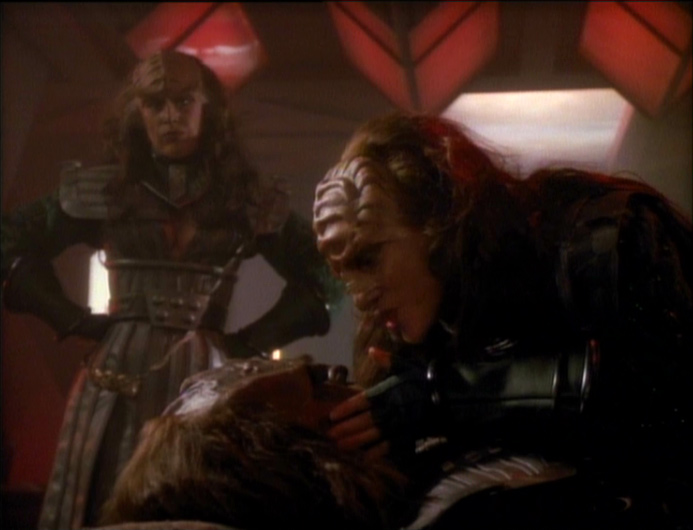
What doesn’t hold up
Part I mostly works, though it’s weird that Worf wears his Starfleet uniform while on leave and doing back-alley stuff with Kurn and Gowron. Isn’t that sort of representing the Federation in internal Klingon affairs? Oh, and since when can women not serve on the High Council? Gowron offered K’Ehleyr a spot there in “Reunion” and Azetbur serves as head of the council in “Star Trek VI: The Undiscovered Country”. Now, the second instance was produced AFTER this episode premiered, but still. Are we to believe that Klingons became less progressive after “Reunion”? Maybe it’s because all their blood turned red?
Part II is far more problematic. Picard’s blockade doesn’t make a ton of sense — as we’re talking about, you know, three-dimensional space. Couldn’t the cloaked Romulan ships just fly around the Starfleet vessels? I guess that doing so would have slowed them down …
Also, what’s the deal with Worf when he sees Sela on the viewscreen after he’s captured by Lursa and B’Etor? He hardly reacts — when his reaction should be like Picard’s from earlier in the episode (my guess is a scene where he learned of Sela was cut for time). Speaking of weird reactions, the whole business on the Sutherland — the ship Data commands in the blockade — was poorly done. Hobson (Timothy Carhart), Data’s first officer, is WAY too pig-headed in his distrust of Data. And the drama at the end where Data defies orders to test his theory — when he could have messaged Picard to stand by while he tested another approach — was dumb.
There’s also the matter of Romulan supplies being key to the Duras’s war efforts. What kind of supplies are we talking about? Weapons? Food? Dilithium? Pink blood? If Picard’s big idea is to use the blockade to demonstrate Romulan involvement, why didn’t he try to determine whether any recovered supplies could be traced to the Romulans? Surely, some ship wreckage could have been obtained or Data and Geordi could have done some technical magic to determine whether anything was of a Romulan origin (as they did with a detonator in “Reunion” and with phasers in “The Mind’s Eye”).
Honestly, the blockade/supply business is something that might make sense in a story about a 20th-century naval battle. But it’s almost preposterous in a universe where ships can travel in three dimensions and replicators and other technology are available. Unless the Romulans were providing fully functional ships or troops — which would have obviously been traced back to them — what supplies could they have provided that weren’t easily attainable?
Finally, it’s hard to believe that Worf could just resume duty with no questions asked. Picard likely could have stalled on filing the resignation paperwork. But what if the war had gone on longer than what seems like a few weeks? Given the dialog at the end of part one — in which Worf talks about how he has spent most of his life around humans — it would have been much more believable for Worf to stay with his people, especially given the high standing his family has in the years to come. He, Gowron and Kurn could have pretty much ruled the empire — but Worf goes back to being a lieutenant in Starfleet? Hmmm …
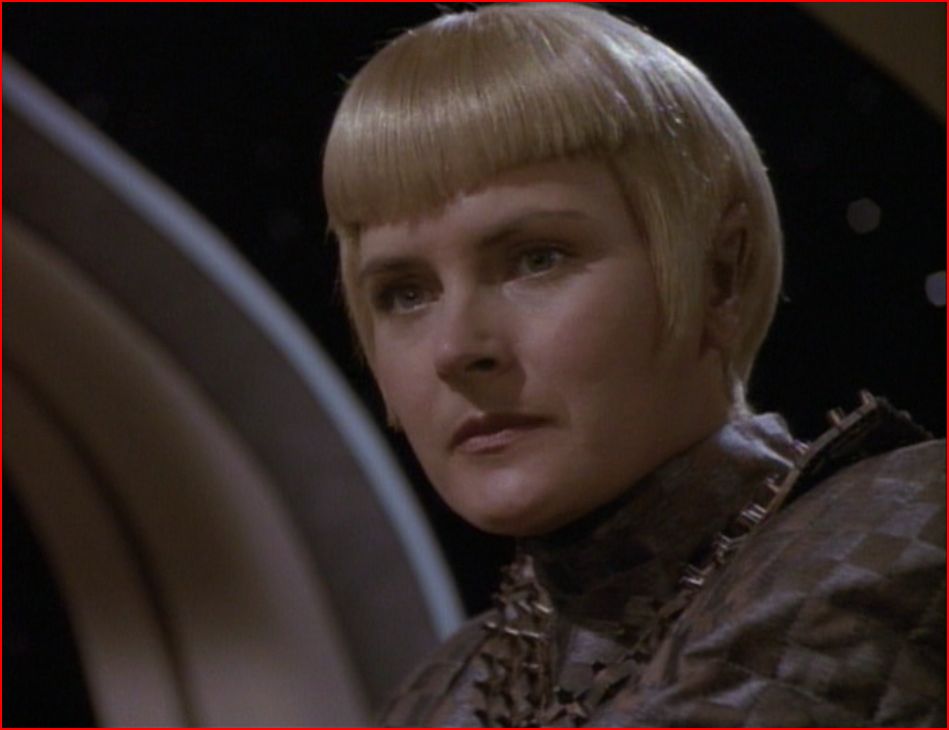
Final thoughts
Part II reminds me of the TV show “LOST” or the worst of the rebooted “Battlestar Galactica”. Glaring logical problems are necessary to prop up (somewhat) compelling drama and action. It’s a shame, because the Klingon intrigue was a major undercurrent of second-generation Trek, and a lot of it works, especially the back stories and the general look and feel.
That said, even part II has some cool moments, like the scene on Kurn’s ship to start the episode. The Klingon stuff in TNG is really the closest thing the series had to a mini arc (other than the Borg stuff and the regular Q episodes). TNG, of course, aired in an era when serialized dramas were much less common than they are today — or even when the other three second-generation series were being broadcast.
Coming later this week …
Here come the Bajora. I mean, the Bajorans …

